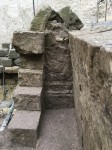 The construction of Rome’s new metro line has encountered yet another archaeological marvel: a Republican-era aqueduct dating to around the 3rd century B.C., likely a section of the first aqueduct built in Rome. Archaeologists found the structure during construction of a ventilation shaft under Piazza Celimontana on the Celian hill. The shaft’s 18-meter (60-foot) depth allowed them unique access to the 3rd century layers of the city. Without the bulkheads keeping the water from flooding the site, it wouldn’t have possible to excavate anywhere near that deep.
The construction of Rome’s new metro line has encountered yet another archaeological marvel: a Republican-era aqueduct dating to around the 3rd century B.C., likely a section of the first aqueduct built in Rome. Archaeologists found the structure during construction of a ventilation shaft under Piazza Celimontana on the Celian hill. The shaft’s 18-meter (60-foot) depth allowed them unique access to the 3rd century layers of the city. Without the bulkheads keeping the water from flooding the site, it wouldn’t have possible to excavate anywhere near that deep.
“The opportunity to safely reach this depth allowed us to uncover and document an exception sequence of stratigraphy and structures from the Iron Age (tombs and grave objects from the tenth century BC) to the modern age (foundations of 19th-century housing,” [sic] [said lead archaeologist Simona Morretta].
Because the structure was buried under intact layers of earth, the team was able to work out that after falling out of use as an aqueduct, Romans living in the first century BC used it as a sewer.
What’s more, close examination of the earth revealed the remains of food leftovers, offering an insight into what Romans used to eat, and the animals they kept as pets – from wild boars to swans, pheasants, and large seawater fish.
 The dating of the aqueduct, determined by the stratigraphy, and its location under the Celian hill point to it being part of the Aqua Appia, the first aqueduct in Rome, built by censors Gaius Plautius Venox and Appius Claudius Caecus in 312 B.C. The source was about 10 miles outside the city, and unlike later aqueducts, almost the entirety of the length of the Aqua Appia was underground. Outside the city it ran through tunnels carved into tufa hills; inside it ran on top of the Servian Wall for stretch, but was mostly carried through channels deep under the city.
The dating of the aqueduct, determined by the stratigraphy, and its location under the Celian hill point to it being part of the Aqua Appia, the first aqueduct in Rome, built by censors Gaius Plautius Venox and Appius Claudius Caecus in 312 B.C. The source was about 10 miles outside the city, and unlike later aqueducts, almost the entirety of the length of the Aqua Appia was underground. Outside the city it ran through tunnels carved into tufa hills; inside it ran on top of the Servian Wall for stretch, but was mostly carried through channels deep under the city.
 Only three sections of the Aqua Appia have been discovered, one by Raffaelo Fabretti in 1667 just inside the Porta San Paolo gate, one by English archaeologist John Henry Parker in the San Saba tufa quarries near the Aventine in 1867, and by Rodolfo Lanciani under the remains of an ancient villa on the Via di Porta San Paolo in 1888. These sections were small and in poor condition, cut tunnels that were later lined with stones.
Only three sections of the Aqua Appia have been discovered, one by Raffaelo Fabretti in 1667 just inside the Porta San Paolo gate, one by English archaeologist John Henry Parker in the San Saba tufa quarries near the Aventine in 1867, and by Rodolfo Lanciani under the remains of an ancient villa on the Via di Porta San Paolo in 1888. These sections were small and in poor condition, cut tunnels that were later lined with stones.
 The newly discovered section is distinct both because it is in exceptionally good condition and because it is a constructed dry stone wall an extraordinary 32 meters (105 feet) long. It is two meters (6.5 feet) high and is made of five rows of large tufa blocks arranged in prism shape. The water was carried from east to west by a lead pipe known as a fistula aquaria.
The newly discovered section is distinct both because it is in exceptionally good condition and because it is a constructed dry stone wall an extraordinary 32 meters (105 feet) long. It is two meters (6.5 feet) high and is made of five rows of large tufa blocks arranged in prism shape. The water was carried from east to west by a lead pipe known as a fistula aquaria.
Because the structure is buried so deep, it wouldn’t be possible to put the aqueduct on display in situ. Archaeologists are therefore dismantling the whole thing in order to rebuild in a new location as yet to be determined.